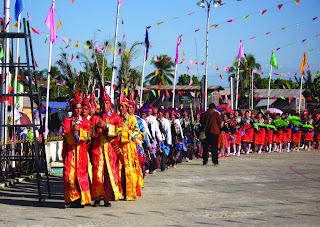Oooh! Pretty butterfly! Eh....no...moth. Uh...butterfly? No, moth? Urm...maybe butterfly?!URGH! WHAT'S THE DIFFERENCE?! Both have wings and fly!
Raise your hands if you get confused, or worse still, go by the colour method: butterflies are colourful and beautiful, moths are dull and ugly. *sheepishly raising our collective hands* Be prepared to be enlightened, fellow mortals.
 |
| Day flying moth (Syntomis huebneri) |
- Butterflies tend to close up their wings when they're sitting somewhere, whereas moths tend to rest with their wings open, like in the picture above, of the Day flying moth spotted at Sebana. Apparently butterflies are more self conscious about their bodies... seems to be that beautiful individuals tend to be eh? (not that we're saying that moths aren't beautiful, for all you moth-fans out there)
- Butterflies are also usually out and about during the day, whereas moths, like Grant, are often only out drinking(Nectar, not beer! For the moths at least...) at night. One of several exceptions to this 'rule' is the moth above, which is hence unimaginatively named 'Day flying moth'.
- Many butterflies are slim and smooth, whereas moths tend to be fat and fuzzy. Kind of like a teddy bear with wings. Well... not really, but you get the picture :)
- Butterflies do tend to be more brightly coloured, whilst moths, our furry creatures of the night, tend to be dull coloured-brown, grey, black, or white. Moths that are active in the day, like the one above, tend to be more brightly coloured though.
- Look closely with your superior ocular powers and you will notice(assuming that they keep still, which in reality, is an uncommon occurrence) that butterflies have knobbed/clubbed antennae whereas the antennae of moths is much more variable. This is pretty much why the Order Lepidoptera used to be further divided into the suborders of Rhopalocera(clubbed antennae, i.e. butterflies) and Heterocera(non-clubbed antennae).
| Clubbed antennae of most butterflies [Image adapted from this website on 19 May 2010] |
Important Note: These are characteristics mankind(and possibly womankind as well) has described as belonging to butterflies or moths. There are plenty of exceptions! They are not going to comply with our rules just because we want it to!
Be humbled by the grandeur that is nature :)
Be humbled by the grandeur that is nature :)
References
The Field Museum. (2007). Research & Collections: Zoology: Butterflies: Butterfly Basics: Butterflies vs. Moths. Retrieved May 21, 2010, from The Field Museum: http://www.fieldmuseum.org/
















